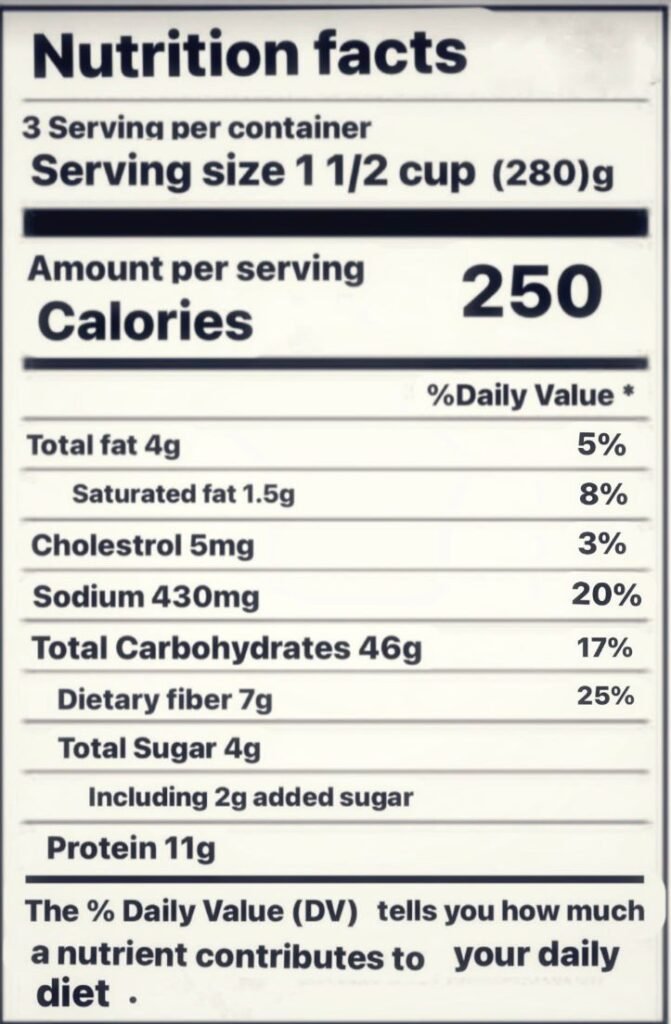
The Nutrition Food Labels is a vital tool for understanding the nutritional composition of packaged foods. It provides information about the nutrients contained in a product and helps consumers make informed choices about their diet. While it’s not typically found on fresh foods like fruits, vegetables, and meats, this label is commonly seen on the outside of most packaged food items. Let’s explore what you can expect to find on a Nutrition Facts Label:

1. Serving Size
The first item on a food label is the serving size. This information tells you the recommended portion size for that product. Pay attention to it because all the nutritional information that follows is based on this serving size. Be mindful of how your portion compares to this standard when assessing the nutritional content.
2. Calories
The calorie count listed on the label represents the amount of energy you’ll get from consuming one serving of the product. This figure is crucial for managing your daily calorie intake and maintaining a balanced diet. Remember that the number of calories you should consume daily varies depending on factors like age, gender, and activity level.
3. Nutrients
Food labels provide a breakdown of key nutrients, which typically include:
- Fat:
- To begin with, consider both total fat and saturated fat content.
- Furthermore, it’s essential to limit saturated fat intake due to its link to heart disease.
- Additionally, in moderation, healthy fats from nuts and avocados can be beneficial.
- Cholesterol:
- Turning our attention to cholesterol, it’s exclusively found in animal products.
- Moreover, it’s crucial to keep an eye on cholesterol content, especially if you have cardiovascular concerns.
- High cholesterol intake, as a result, can contribute to clogged arteries.
- Sodium:
- Moving on to sodium, it measures the salt content in food.
- In addition, sodium plays a crucial role in maintaining hydration and regulating tissue water levels.
- Consequently, excessive sodium intake is associated with high blood pressure.
- Therefore, it’s advisable to choose products with lower sodium levels.
- Carbohydrates:
- Shifting focus to carbohydrates, they provide energy for muscles and the brain.
- Furthermore, this section on food labels often includes dietary fiber and sugars.
- As a result, aiming for products with higher fiber and lower added sugar content is recommended for better nutrition.
- Protein:
- Lastly, when considering your diet, don’t forget about protein.
- Especially if you’re physically active, it’s essential to consider your protein needs.
- In summary, protein is vital for building and repairing tissues.

4. % Daily Value (DV)
The % Daily Value helps you gauge how a serving of the product fits into your daily nutrient requirements. It’s based on a daily intake of 2,000 calories, so keep in mind that your individual needs may vary. Aim for foods with higher % DV for essential nutrients like fiber, vitamins, and minerals and lower % DV for saturated fat, cholesterol, and sodium.
5. Ingredient List
The ingredient list is where you’ll find the components that make up the product. Ingredients are listed in descending order by weight, meaning the first ingredient is the most abundant. Look out for added sugars, artificial additives, and preservatives. Familiarize yourself with ingredient names you want to avoid or minimize in your diet.
Becoming proficient in reading food labels empowers you to make healthier choices for you and your family. By paying attention to serving sizes, calories, nutrients, and ingredient lists, you can make informed decisions that align with your dietary goals and promote better overall health. Remember, the food label is your ally in navigating the complex world of nutrition, helping you make choices that contribute to a balanced and wholesome diet
How To Read Nutrition Facts Labels





